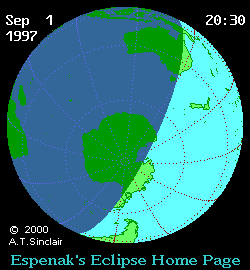Solar eclipse of September 2, 1997
A partial solar eclipse occurred on Tuesday, September 2, 1997. A solar eclipse occurs when the Moon passes between Earth and the Sun, thereby totally or partly obscuring the image of the Sun for a viewer on Earth. A partial solar eclipse occurs in the polar regions of the Earth when the center of the Moon's shadow misses the Earth.
| Solar eclipse of September 2, 1997 | |
|---|---|
 Map | |
| Type of eclipse | |
| Nature | Partial |
| Gamma | -1.0352 |
| Magnitude | 0.8988 |
| Maximum eclipse | |
| Coordinates | 71.8°S 114.3°E |
| Times (UTC) | |
| Greatest eclipse | 0:04:48 |
| References | |
| Saros | 125 (53 of 73) |
| Catalog # (SE5000) | 9502 |
Images

Related eclipses
Eclipses of 1997
- A total solar eclipse on March 9.
- A partial lunar eclipse on March 24.
- A partial solar eclipse on September 2.
- A total lunar eclipse on September 16.
Solar eclipses 1997–2000
This eclipse is a member of a semester series. An eclipse in a semester series of solar eclipses repeats approximately every 177 days and 4 hours (a semester) at alternating nodes of the Moon's orbit.[1]
| Solar eclipse series sets from 1997–2000 | ||||||
|---|---|---|---|---|---|---|
| Descending node | Ascending node | |||||
| Saros | Map | Gamma | Saros | Map | Gamma | |
120 Chita, Russia | 1997 March 09 Total | 0.91830 | 125 | 1997 September 02 Partial (south) | -1.03521 | |
130.jpg.webp) Total eclipse near Guadelope | 1998 February 26 Total | 0.23909 | 135 | 1998 August 22 Annular | -0.26441 | |
| 140 | 1999 February 16 Annular | -0.47260 | 145 Totality from France | 1999 August 11 Total | 0.50623 | |
| 150 | 2000 February 05 Partial (south) | -1.22325 | 155 | 2000 July 31 Partial (north) | 1.21664 | |
| Partial solar eclipses on July 1, 2000 and December 25, 2000 occur in the next lunar year eclipse set. | ||||||
Metonic series
The metonic series repeats eclipses every 19 years (6939.69 days), lasting about 5 cycles. Eclipses occur in nearly the same calendar date. In addition, the octon subseries repeats 1/5 of that or every 3.8 years (1387.94 days). All eclipses in this table occur at the Moon's ascending node.
| 21 eclipse events between June 21, 1982, and June 21, 2058 | ||||
|---|---|---|---|---|
| June 21 | April 8–9 | January 26 | November 13–14 | September 1–2 |
| 107 | 109 | 111 | 113 | 115 |
| June 21, 1963 | April 9, 1967 | January 26, 1971 | November 14, 1974 | September 2, 1978 |
| 117 | 119 | 121 | 123 | 125 |
 June 21, 1982 |
 April 9, 1986 |
 January 26, 1990 |
 November 13, 1993 |
 September 2, 1997 |
| 127 | 129 | 131 | 133 | 135 |
 June 21, 2001 |
 April 8, 2005 |
 January 26, 2009 |
 November 13, 2012 |
 September 1, 2016 |
| 137 | 139 | 141 | 143 | 145 |
 June 21, 2020 |
 April 8, 2024 |
 January 26, 2028 |
 November 14, 2031 |
 September 2, 2035 |
| 147 | 149 | 151 | 153 | 155 |
 June 21, 2039 |
 April 9, 2043 |
 January 26, 2047 |
 November 14, 2050 |
 September 2, 2054 |
| 157 | ||||
 June 21, 2058 | ||||
References
- van Gent, R.H. "Solar- and Lunar-Eclipse Predictions from Antiquity to the Present". A Catalogue of Eclipse Cycles. Utrecht University. Retrieved 6 October 2018.
External links
Photos:
- APOD 9/3/1997, A Partial Eclipse in Southern Skies, partial eclipse from Kingscote, Kangaroo Island, South Australia
.jpg.webp)

